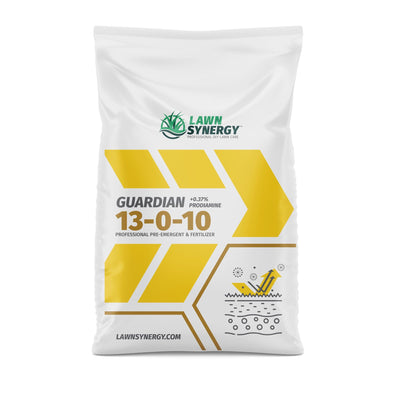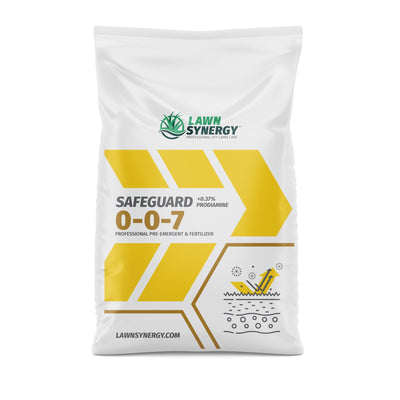The most effective way to stop weeds is to prevent them from ever sprouting, and that starts with a smart pre-emergent schedule.
For homeowners who care about their lawns, understanding when and how to apply pre-emergents can make the difference between a lush green yard and a weedy, patchy mess.
In this guide, you'll learn exactly how to time your pre-emergent applications based on your grass type, region, and seasonal cycles.
We'll break down spring and fall timing, give you a calendar to follow, and share estate-care insights from Lawn Synergy's 30+ years of real-world turf experience.
What this article covers:
- What Is a Pre-Emergent Schedule and Why Does It Matter?
- Spring Application Timing
- Fall Application Timing
- Annual Pre-Emergent Calendar
- Choosing the Right Product by Season
- How to Know It's Time to Apply
What Is a Pre-Emergent Schedule and Why Does It Matter?
Pre-emergent herbicides are designed to stop weed seeds from sprouting. But they're time-sensitive tools: they only work if applied before the seeds germinate. Miss that window, and the product won't do a thing to stop weeds from emerging.
That's why a carefully timed pre-emergent schedule is essential.
A strong schedule aligns your application with soil temperatures, regional climate, and weed germination cycles. It also takes your grass type into account, since warm- and cool-season lawns respond differently to seasonal pressure.
When you time it right, you create an invisible barrier in the soil that blocks weeds like crabgrass, poa annua, spurge, henbit, and others from ever seeing daylight — all without damaging your turf.
This approach is the core of professional lawn care. For DIY homeowners, it's the fastest way to shift from reactive weed treatments to proactive, season-long control.

Spring Application Timing
Spring is the most critical season for pre-emergent use, especially if you're battling crabgrass or other summer annual weeds.
When to Apply
In most climates, apply your pre-emergent when soil temperatures reach 55°F for several consecutive days. This usually occurs in late February through early April, depending on your region. Use a soil thermometer or check local extension reports for daily averages.
This prevents the most common weeds:
- Crabgrass
- Goosegrass
- Foxtail
- Spurge
- Barnyardgrass
These grassy weeds thrive in disturbed or thinning turf and can quickly take over by midsummer if not controlled early.
Regional Timing Tips
- Southern Lawns (Florida, Texas, Carolinas): Apply as early as mid-February. Follow up with a second round in late spring for extended protection.
- Northern Lawns (Midwest, Northeast): Target mid-March to mid-April. Soil warms more slowly here, so timing is naturally delayed.
For best results, use a granular product like Guardian 13-0-10, which contains prodiamine plus potassium for early root strength. For more details, check out this guide on how to apply pre-emergent in spring.
Fall Application Timing
Fall is often overlooked, but it's just as important, especially for lawns that struggle with winter and early-spring weeds.
When to Apply
Apply in late August through October when soil temperatures dip back into the 70s. This is when cool-season weeds like poa annua and chickweed begin to germinate.
It targets fall weeds, including:
- Annual bluegrass (Poa annua)
- Chickweed
- Henbit
- Rescuegrass
- Corn speedwell
These weeds typically emerge in fall, overwinter, and go to seed in spring, making fall prevention essential for long-term control.

Special Considerations for Warm-Season Lawns
In southern zones, fall pre-emergents are especially critical. Weeds that sneak in during your turf's dormancy will thrive before you even notice. Use Safeguard 0-0-7 to block germination without overfeeding your warm-season grass as it winds down.
Annual Pre-Emergent Calendar
Lawns across the U.S. don't warm up at the same pace, which means your pre-emergent schedule should be tailored to your region's climate, not the calendar. Soil temperature (not air temperature) is the best indicator for application timing.
Cool-Climate Lawns (Northern States)
In cooler areas like the Northeast, Upper Midwest, and Pacific Northwest, spring comes later and fall arrives sooner.
You'll typically apply:
- Spring: Mid-March to mid-April
- Fall: Early September to early October
Warm-Climate Lawns (Southern States)
In southern regions such as the Southeast, Deep South, and Gulf Coast, soil warms earlier and stays warm longer.
These lawns often need an extended pre-emergent strategy:
- Spring: Mid-February to mid-March, with a second application around May
- Fall: Late August to mid-September
Sample Timeline by Region
|
Region |
Spring Application |
Fall Application |
|
Florida |
Feb 15 – Mar 15 |
Aug 20 – Sep 15 |
|
North Carolina |
Mar 1 – Apr 1 |
Sep 1 – Sep 30 |
|
Midwest |
Mar 15 – Apr 15 |
Sep 10 – Oct 10 |
|
Northeast |
Mar 20 – Apr 20 |
Sep 15 – Oct 15 |
Your microclimate may differ, especially in areas with wide temperature swings or mixed elevations. Use a soil thermometer or online soil temperature tracker to dial in your exact application window.

Choosing the Right Product by Season
Spring pre-emergents often double as a gentle kickstart for turf growth. Fall applications typically avoid nitrogen to prevent unwanted top growth before dormancy.
-
Guardian 13-0-10: Ideal for spring and fall with potassium support.
-
Safeguard 0-0-7: Best for low-nitrogen control during late-season or second applications.
- Pair with Almighty 20-0-10 if your lawn needs an extra nutrient push after application.
Both options are estate-tested and designed to give DIY homeowners a clear edge.
How to Know It's Time to Apply
Relying on the calendar alone is risky. A week of warm weather can throw off your schedule if you're not paying attention.
Soil Temperature Cues
Soil temperature is the most reliable signal for pre-emergent timing. Use a digital soil thermometer to measure the top 2 inches of soil in the early morning. When it consistently hits 55°F in spring or drops back to 70°F in fall, it's go time.
That's the temperature range when weed seeds like crabgrass and poa annua begin to germinate. If your pre-emergent isn't already in the soil forming a barrier, you're too late.
Visual Signs in Your Yard
If you don't have a soil thermometer, your landscape can still offer valuable clues:
- Forsythia blooming: These bright yellow bushes are one of the most reliable natural indicators that crabgrass season is about to begin.
- Early dandelions: When you see those first yellow flowers, your soil is warming up, and summer weed seeds are waking up too.
- Fall leaf drop: When trees begin to shed their leaves, winter annuals like chickweed and henbit are ready to sprout beneath the surface.
Paying attention to these signs helps you apply just in time, neither too early nor too late.

Tools and Apps to Use
If you want a more precise approach (without digging up soil every day), there are reliable digital tools that track soil temperature across the U.S.:
- Greencast Online Soil Temperature Map (by Syngenta): A free, zip-code-based map that shows real-time soil temperatures down to the root zone level.
- University Extension Services: Most land-grant universities offer regional turf alerts, planting calendars, and weed emergence reports.
- Home Weather Stations: Many newer models include soil probes or temperature sensors that track trends throughout the day and night.
These tools give you a tactical edge, helping you sync your application to actual conditions, not just guess based on past years.
Conclusion
Your pre-emergent schedule is the backbone of smart weed control. Get the timing right, choose the right product, and you'll block weeds before they become a problem.
At Lawn Synergy, we're here to help you get estate-level results on your own terms — with professional-grade products, regional advice, and no-nonsense support across Florida, North Carolina, and beyond.
Have questions about your specific lawn? Reach out today or explore our full lineup of weed control and lawn nutrition products.
Ready to learn more about lawn care? Check out these articles:



